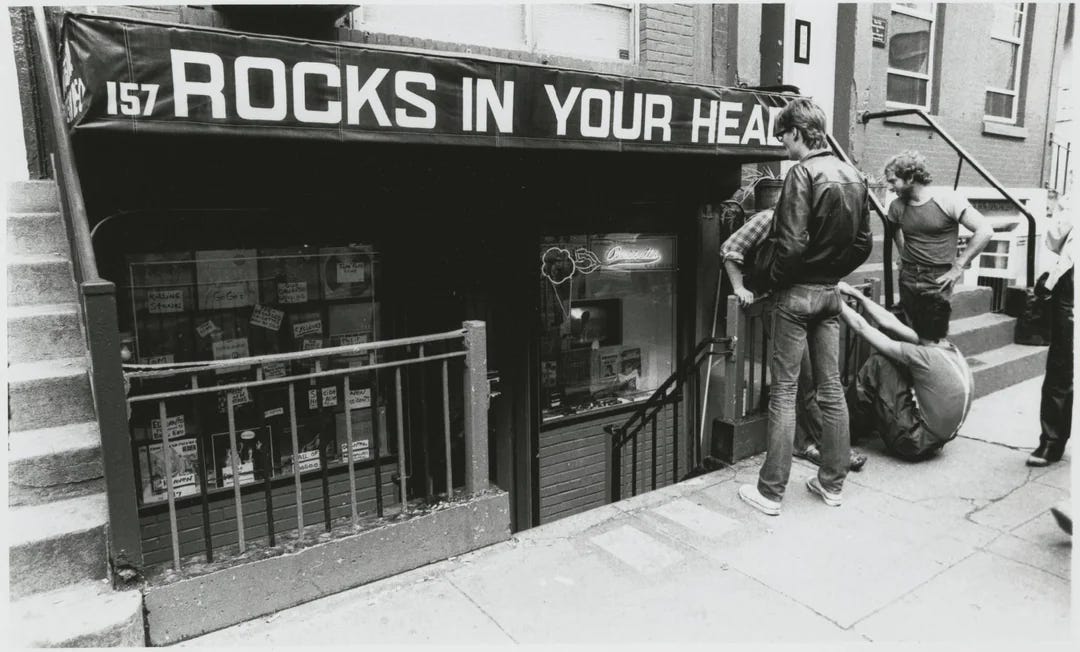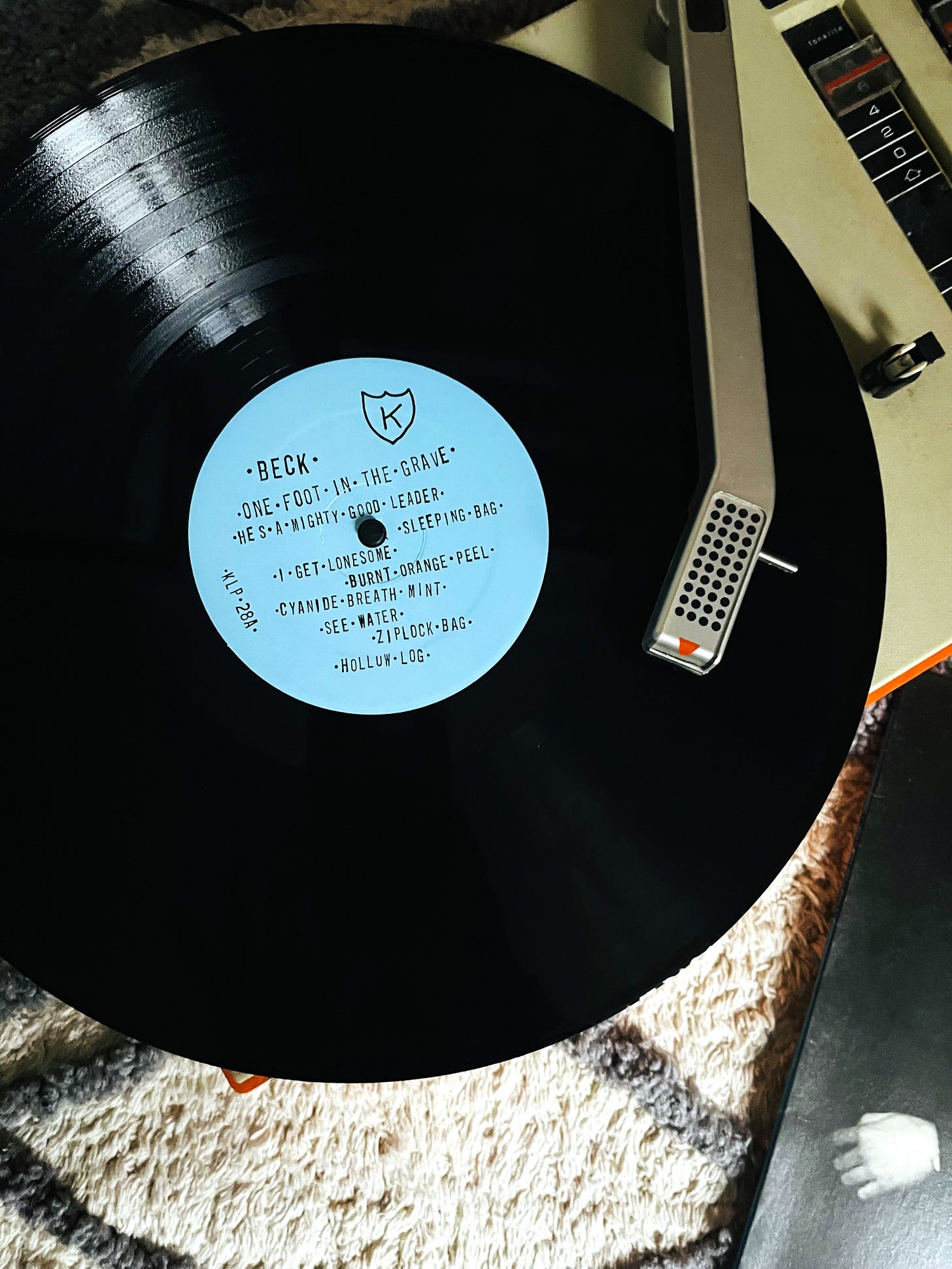Happy Day of the Dead, mes amis.
How fitting I would pick this record on the first of November, the day after our souls left our bodies for Hallow’s Eve and now I’m kicking it off with a record titled, One Foot in the Grave. Spooky, spooky.
So, I know that Sea Change gets a lot of love as being the beloved acoustic Beck album. And with good reason. It’s got soul. It’s got heartbreak. It’s got some major L’Histoire de Melody Nelson vibes (those strings in “Paper Tiger” is made for music nerds in me to short circuit at what feels like a direct reference to “Hôtel Particulier”) But here’s where I go off the beaten track…while I love me some Sea Change, especially as these colder months creep in, my first love will always be One Foot in the Grave.
Kicking it back to the fall of 1996, I was coming down from my summer of love with Odelay, which had me retrace some Mellow Gold steps. These two danceteria-by-way-of-a-hip-hop-folk-singer-who-likes-his-samples albums sufficiently left their mark on the summer of my first job, when I commuted solo into Manhattan to slice bread for rich people. My favorite track on Odelay, the contemplative and stripped-down “Ramshackle,” had song sepia-toned my last days of that summer, preparing me for fall. And now it was here. High school had started, and I seemed to understand people my age less and less. I shelved my grooveadelic Beck cassettes, seeking an emotional transition I expected of the season and suspected the artist was capable of.
Enter One Foot in the Grave.
I was aware of its existence. From a magazine article? A chat in an AOL indie rock chat room? Those origins are unclear. But since we’ve transported to the ye old times of dial-up Internet when entire songs weren’t a tap away, I didn’t know what it sounded like. Discovering music, then was a ritual of sorts. And that ritual usually started with waiting. Waiting for the weekend, waiting to get paid, waiting to get a ride. Then came the gamble: would the album be worth it? This was where album art played a pivotal role, which was also a toss-up. But that was the adventure in finding new music.
That year, my summer job turned into a weekend job, and post-bread-slicing shift, I set off to deepen my Beck fandom with this album. Before hopping on a train back to Long Island, I made my monthly pilgrimage to Rocks in Your Head record shop in SoHo. Now defunct, it was one of those shops that, though tiny, had everything one could possibly need in 1996 from zines to Built by Wendy guitar straps to the entire Matador catalog. I descended into what felt like an underground haven, making a beeline to the B’s. The B’s, by the way, were my favorite letter in the vinyl alphabet when I was a teen because Bikini Kill, Babes in Toyland, Bratmobile, Belly, Black Francis, Ben Folds Five, Björk, Blur, Beastie Boys, Beach Boys, Beck. I usually got stuck in traffic here.
And behind a copy of Beck’s Stereopathetic Soulmanure was One Foot on the Grave. I snagged it for 11.99 plus his “Steve Threw Up” 7” single, paid cash and headed for the Subway. At Penn Station, with the album tucked under my arm, I called my mom collect using the trick of giving my operator my name as the train’s arrival time to avoid charges.
“Hello, would you accept a collect call from 6:17 Mineola?”
On the ride home, I watched the sun set, its hues painting the New York City skyline, which still included the Twin Towers, a gold you only get this time of year. As the cityscape shrank into the distance, becoming nothing more than Lego bricks by the time I reached the outer edges of Queens, I turned my attention to my new record. Pulling it out of the shopping bag, I examined the cover trying to imagine its sound. There, I learned it was released on the iconic Olympia-based K Records label. The artwork, an embodiment of the label’s minimalistic aesthetic complete with a seasonal flair: Beck’s Kool-Aid scarf, an acoustic guitar, a bare tree, his faraway gaze. And some guy I didn’t recognize. The black and white image struck a chord with me, evoking a spirit of fall, before its warmth became manufactured.
When my mom picked me up (at 6:17), we headed straight to my grandmother’s for dinner. There, in her 1960s den that smelled of hardcover books and fireplace remains, I tore off the cellophane and dropped the needle on the black and white beauty. I don’t know if it was just the setting, the season, or that I was simply in my teenage Beck moment, but it was, well, perfect.
I closed my eyes, letting the starkness of the album wash over me, this homage to his acoustic roots. The collection of both folk and anti-folk songs felt as intimate as walking into someone’s home. Self-produced, as the best art often is, with barebones production captured lo-fi in a way that felt haunting, not distracting. The lyrics, profound and humorous (sometimes profoundly humorous!), paint this mosaic of emotions, reflecting life’s quieter more reflective moments. Recorded on a 4-track cassette, it felt personal, close to home, and it still does. I find myself reaching for it every season to revisit a moment in my teenage life when music was more than a sound, it was a connection to a part of me. It was idea of what I wanted in life but couldn’t quite articulate, all I knew was that it sounded like this.
Album favorites:
“Sleeping Bag”, “Outcome”, “Painted Eyelids”, “Atmospheric Conditions”, and of course, the best love song ever: “Asshole”.







